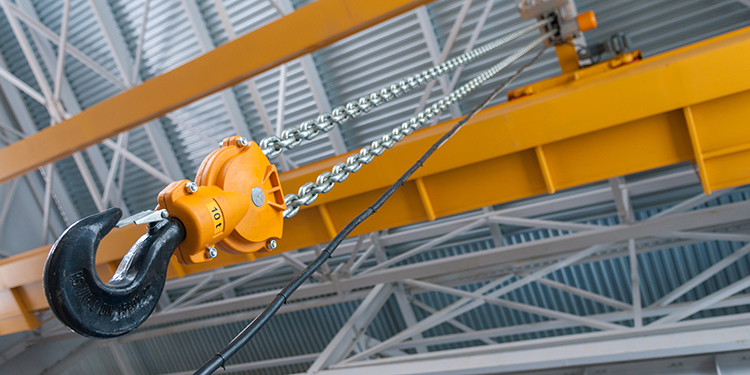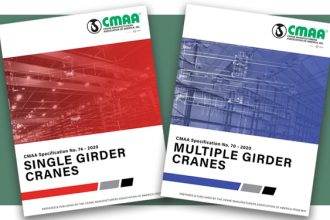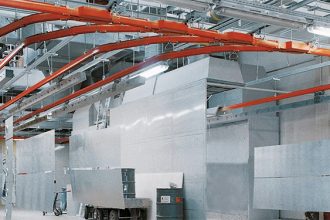
As a critical component of overhead handling equipment, manual, air and electric hoists make it possible to lift freely suspended, bulky loads up for positioning or transport, and lower down for precise placement. Because they are supplied separately from an overhead crane, monorail, or workstation crane, hoists can be easily exchanged among different types of overhead lifting systems. They can also be equipped with a variety of different below-the-hook lifting devices such as hooks, magnets, slings, grippers, beams, or vacuum cups.
Hoists enhance an operation’s ergonomics by taking the strain of repetitively lifting heavy objects manually away from workers, as well as increasing handling efficiency and productivity. However, to ensure their safest use facilities utilizing hoists in their operation have a variety of responsibilities that are critical to the safe operation of this equipment. That’s why the Hoist Manufacturers Institute (HMI) publishes multiple specifications and recommended practices for hoist design, operation and service. In addition, the members of HMI have also assembled a list of hoist “Dos and Don’ts.” Following these recommendations will enhance both the integrity and reliability of the equipment, as well as reduce the risk of injury for workers as they operate a hoist in conjunction with other overhead lifting equipment, or work in proximity to it.
Hoist Dos…
- Do ensure that the hoist and lifting equipment are properly sized to handle the load when specifying/purchasing the equipment. Selecting a hoist that is sufficient (or slightly more so) for the lifting speed, weight capacity and duty service of the handling application means that the lifting device is sized correctly for the load and will perform as expected.
- Do read the owner’s manual. These documents — developed by the hoist’s manufacturer — contain important information, such as specifications, dimensions, operation instructions, inspection criteria, parts lists, and more.
- Do understand that the Occupational Safety and Health Administration (OSHA) requires facility operators to provide their employees with equipment (including hoists) that is both safe and operates property.
- Do require hoist operators to know, understand and follow hoist operation guidelines to ensure worker and facility safety.
- Do inspect the hoist prior to the start of each shift before operation using HMI’s pre-inspection checklist that overviews multiple areas of focus, including the operating mechanism, hoist limit devices, hooks, latches, and lifting media (chain, rope or strap), as well as at frequent and periodic intervals.
- Do perform frequent and periodic inspections more often for hoists used in extreme or harsh environments, such as outdoors.
- Do report damage, malfunctions, or unusual performance of the hoist to managers promptly; that hoist should be removed from service immediately.
- Do ensure all employees/operators who will use the hoist have been trained on its proper use and operation by someone who has experience with the equipment.
- Do follow all safety precautions specified by the manufacturer of the hoist when operating the equipment.
- Do require hoist operators to maintain a firm footing when operating the hoist.
- Do check brake function by tensioning the hoist prior to each lift operation.
- Do confirm that the hoist’s limit switches function properly before lifting a load.
- Do take up slack carefully, confirming that the load is balanced and stable and that the load holding action is secure before proceeding.
- Do use hook latches (unless doing so creates a hazardous condition) to retain slings or chains under slack conditions. Do verify that hook latches are closed and not supporting any parts of the load before operating the hoist.
- Do avoid swinging the load or hook.
- Do confirm that hook travel is in the same direction as shown on the controls.
- Do warn personnel in the surrounding areas of an approaching load.
- Do perform regular preventive maintenance, including lubrication, as specified by the hoist manufacturer to ensure long service life.
- Do replace damaged or worn parts and keep appropriate records of hoist maintenance.
- Do engage independent service and inspection professionals with experience on the specific equipment if outsourcing preventive maintenance and repairs.
Hoist Don’ts…
- Don’t misplace or throw away the owner’s manual. This document is a critical resource for owners and operators of hoists.
- Don’t allow untrained operators to use the hoist or any overhead lifting equipment.
- Don’t attempt to operate a hoist that has been tagged out-of-service.
- Don’t allow an operator to attach a load to a hoist without first having proper training.
- Don’t attempt to lift a load that exceeds the capacity rating of the hoist.
- Don’t use the hoist load limiting or warning device to measure a load.
- Don’t use limit switches as routine operating stops; they are emergency devices only.
- Don’t use a hoist that has a twisted, kinked, damaged or worn wire rope or chain.
- Don’t use a hoist that has missing or illegible safety placards or decals. Don’t remove these warnings.
- Don’t operate a damaged, malfunctioning, or unusually performing hoist.
- Don’t allow an operator to use the hoist until he or she has thoroughly read the manufacturer’s operating and maintenance instructions.
- Don’t use limit switches as a routine method to stop load movement; this will cause premature wear of the components.
- Don’t operate the hoist beyond the travel limits of the load wire rope or chain.
- Don’t apply the load unless the load chain is properly seated in the chain wheels or sprockets, or the wire rope is properly seated in its grooves.
- Don’t use the hoist for any purpose outside its specified function, including lifting, supporting, or transporting people.
- Don’t lift or move loads over people.
- Don’t operate the hoist unless the load is centered beneath it.
- Don’t permit operators to attempt a side-pull (pulling the hoist and its chain or wire at an angle and out of plumb from under the trolley and overhead lifting equipment) to reach a load.
- Don’t attempt to lengthen or repair the load wire rope or chain.
- Don’t use the load wire rope or chain as a sling, nor wrap the wire or chain around a load.
- Don’t apply the load to the tip of the hook, and don’t apply the load unless all supporting chains, ropes or web straps are equally loaded.
- Don’t operate a hoist unless it has been securely attached to a suitable support with adequate capacity to hold the load.
Need more information on hoists? The members of the Hoist Manufacturers Institute (HMI) offer a variety of resources — including a comprehensive library of product guides; a hoist certification program; OSHA Alliance safety tip sheets, fact sheets and quick cards; multiple technical papers and more — via its website at www.MHI.org/hmi.



